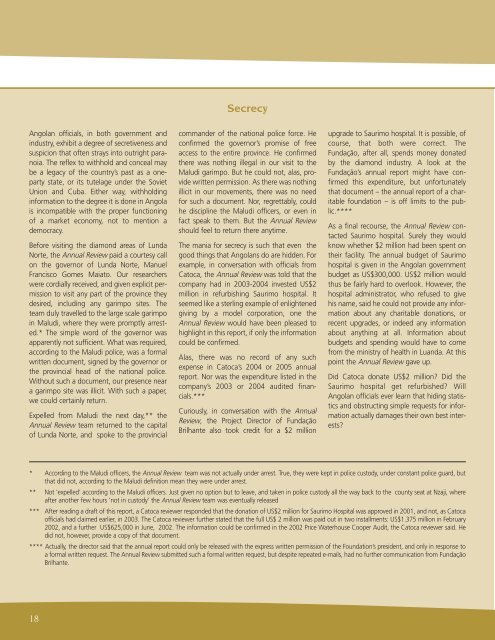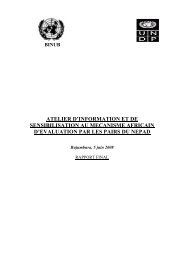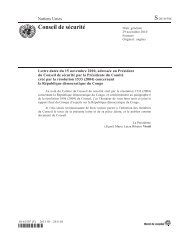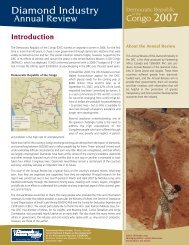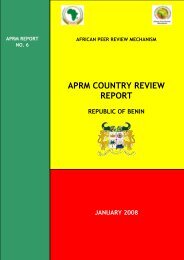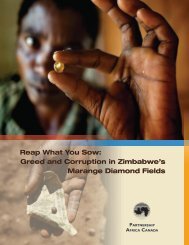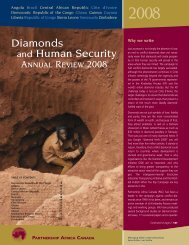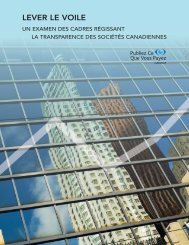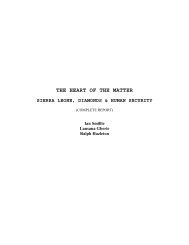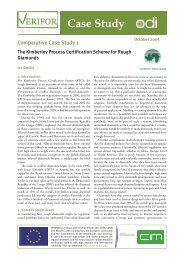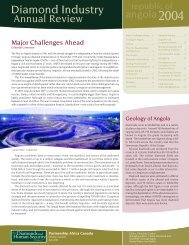Secrecy<strong>Angola</strong>n officials, in both government andindustry, exhibit a degree of secretiveness andsuspicion that often strays into outright paranoia.The reflex to withhold and conceal maybe a legacy of the country’s past as a onepartystate, or its tutelage under the SovietUnion and Cuba. Either way, withholdinginformation to the degree it is done in <strong>Angola</strong>is incompatible with the proper functioningof a market economy, not to mention ademocracy.Before visiting the diamond areas of LundaNorte, the Annual Review paid a courtesy callon the governor of Lunda Norte, ManuelFrancisco Gomes Maiato. Our researcherswere cordially received, and given explicit permissionto visit any part of the province theydesired, including any garimpo sites. Theteam duly travelled to the large scale garimpoin Maludi, where they were promptly arrested.*The simple word of the governor wasapparently not sufficient. What was required,according to the Maludi police, was a formalwritten document, signed by the governor orthe provincial head of the national police.Without such a document, our presence neara garimpo site was illicit. With such a paper,we could certainly return.Expelled from Maludi the next day,** theAnnual Review team returned to the capitalof Lunda Norte, and spoke to the provincialcommander of the national police force. Heconfirmed the governor’s promise of freeaccess to the entire province. He confirmedthere was nothing illegal in our visit to theMaludi garimpo. But he could not, alas, providewritten permission. As there was nothingillicit in our movements, there was no needfor such a document. Nor, regrettably, couldhe discipline the Maludi officers, or even infact speak to them. But the Annual Reviewshould feel to return there anytime.The mania for secrecy is such that even thegood things that <strong>Angola</strong>ns do are hidden. Forexample, in conversation with officials fromCatoca, the Annual Review was told that thecompany had in 2003-2004 invested US$2million in refurbishing Saurimo hospital. Itseemed like a sterling example of enlightenedgiving by a model corporation, one theAnnual Review would have been pleased tohighlight in this report, if only the informationcould be confirmed.Alas, there was no record of any suchexpense in Catoca’s 2004 or 2005 annualreport. Nor was the expenditure listed in thecompany’s 2003 or 2004 audited financials.***Curiously, in conversation with the AnnualReview, the Project Director of FundaçãoBrilhante also took credit for a $2 millionupgrade to Saurimo hospital. It is possible, ofcourse, that both were correct. TheFundação, after all, spends money donatedby the diamond industry. A look at theFundação’s annual report might have confirmedthis expenditure, but unfortunatelythat document – the annual report of a charitablefoundation – is off limits to the public.****As a final recourse, the Annual Review contactedSaurimo hospital. Surely they wouldknow whether $2 million had been spent ontheir facility. The annual budget of Saurimohospital is given in the <strong>Angola</strong>n governmentbudget as US$300,000. US$2 million wouldthus be fairly hard to overlook. However, thehospital administrator, who refused to givehis name, said he could not provide any informationabout any charitable donations, orrecent upgrades, or indeed any informationabout anything at all. Information aboutbudgets and spending would have to comefrom the ministry of health in Luanda. At thispoint the Annual Review gave up.Did Catoca donate US$2 million? Did theSaurimo hospital get refurbished? Will<strong>Angola</strong>n officials ever learn that hiding statisticsand obstructing simple requests for informationactually damages their own best interests?* According to the Maludi officers, the Annual Review team was not actually under arrest. True, they were kept in police custody, under constant police guard, butthat did not, according to the Maludi definition mean they were under arrest.** Not ‘expelled’ according to the Maludi officers. Just given no option but to leave, and taken in police custody all the way back to the county seat at Nzaji, whereafter another few hours ‘not in custody’ the Annual Review team was eventually released*** After reading a draft of this report, a Catoca reviewer responded that the donation of US$2 million for Saurimo Hospital was approved in 2001, and not, as Catocaofficials had claimed earlier, in 2003. The Catoca reviewer further stated that the full US$ 2 million was paid out in two installments: US$1.375 million in February2002, and a further US$625,000 in June, 2002. The information could be confirmed in the 2002 Price Waterhouse Cooper Audit, the Catoca reviewer said. Hedid not, however, provide a copy of that document.**** Actually, the director said that the annual report could only be released with the express written permission of the Foundation’s president, and only in response toa formal written request. The Annual Review submitted such a formal written request, but despite repeated e-mails, had no further communication from FundaçãoBrilhante.18
Republicof<strong>Angola</strong> <strong>2007</strong>Local Community Impact<strong>Angola</strong>’s diamonds are clearly a resource to be used for the benefit of all<strong>Angola</strong>ns. However, the nearly one million residents of Lunda Norte andLunda Sul suffer disproportionately from the exploitation of <strong>Angola</strong>’s diamondresources. The projects themselves restrict their access to cropland,prohibit their use of local rivers, and in the longer term cause damage tolocal soil and water systems. The imposition of restricted and reservezones subjects residents of the Lundas to arbitrary search and seizure bypolice and private security firms. Their homes and fields can be moved atthe order of a diamond mining project. Their range of economic activityis largely restricted to simple subsistence agriculture.It would be just, therefore, considering the hardships they endure, for thegovernment as caretaker of this resource to devote proportionally moreof the diamond benefits to the people of the Lundas. Public investmentwould also be the best way to convince residents of the Lundas to giveup on garimpo. Unfortunately, the opposite appears to be happening.Successive <strong>Angola</strong>n budgets show the Lundas receiving among the lowestamounts of public investment. Villages in the vicinity of diamond miningprojects – near Cafunfo and Cuango, near Lucapa, and Nzaji andSaurimo and Dundo – show next to no sign of government spending.There are no government public schools, or water supply systems, or publichealth clinics. Roads date from the colonial era, and have not beenrepaired since independence. Agricultural extension programs are nonexistent.This latter is particularly puzzling. In order to discourage illegal garimpo,it would make sense to encourage local residents to devote more energyto small scale agriculture. The numerous diamond projects provide aready market for farmers. However, due to the low productivity of localgrowers and the abysmal condition of roads, many of the projects haveresorted to growing their own food on fields inside their concessions.The experience of the past five years has shown that enforcement measures– just using the stick – has a limited effect in reducing garimpeiroactivity. As part of its package of anti-garimpeiro measures, Endiama andother government agencies should consider partnering with the appropriateagricultural agency to implement agricultural extension projects inthe Lundas, perhaps by providing seed or tools or know-how, or by facilitatingcontacts between diamond projects and associations of localgrowers. As part of this package, the <strong>Angola</strong>n government should investsome of its diamond revenue in rehabilitating the roads in the Lundas, togive farmers easier access to local markets.Fundação BrilhanteRecognizing that neither Endiama nor joint venture projects were expertsin social development, in 2004 Endiama created the Fundação Brilhante,or <strong>Diamond</strong> Foundation, to take charge of all of Endiama’s cultural andcommunity development projects. It was hoped that the joint ventureprojects would begin to channel their social spending through theFundação as well.The Foundation’s Director of Projects, J. Francisco Ganga, has a backgroundin the NGO sector and seems to have a good grasp of many ofthe latest techniques for managing community development projects,such as including end-users in initial planning, and ensuring that developmentprojects use appropriate technology that can be maintained by localpeople over the long term.To date, the Fundação Brilhante had been instrumental in the rehabilitationof a museum in Dundo, Lunda Norte, and has taken a lead role inthe refurbishment of the Iron Palace, an iron-frame heritage building inLuanda, designed by Gustave Eiffel. The Foundation’s plan calls for therefurbished palace, located across the street form Endiama’s headquarters,to be turned into a club for the use of diamond-sector executives. Apamphlet produced by the Foundation claims it has built ten four-roomschools in different villages, three in Luanda, two each in Lunda Norteand Lunda Sul, three elsewhere in <strong>Angola</strong>.Beyond these projects, it is difficult to say what the Fundação Brilhantehas undertaken, or how much money it has spent, or how many communitiesit has aided. The Director of Projects refused to discuss specific projectsor funding, and refused to provide an annual report detailing thefoundation’s activities. Such secrecy is odd in a charitable foundation,though it is in keeping with <strong>Angola</strong>n government culture (see ‘Secrecy’pg. 18). A promotional DVD provided by the Foundation laid claim to variousprojects not yet undertaken, such as the rehabilitation of roads andairports in the Lundas, as well as to projects completed by others, such asthe provision of soymilk to local children in Lunda Sul, a project fundedby Catoca. What the Foundation itself has genuinely accomplishedremains a mystery.The Environment and MiningWhen it comes to the environment and diamond mining, <strong>Angola</strong> is a bitof a Wild West. Overall authority for the environment in <strong>Angola</strong> rests withthe Ministry of Urbanism and Environment. That ministry is wholly absentfrom the diamond mining Lundas. Within the diamond sector, theMinistry of Geology and Mines has, at least on paper, the responsibility toensure compliance with the country’s environmental laws and regulations.In practice, it has fallen to Endiama, as the owner of mineral rightsand as the representative of the <strong>Angola</strong>n State on diamond concessions,to ensure sound environmental practices.Endiama’s response to the environmental challenge posed by diamondmining is a perfect illustration of the problems that accompany Endiama’sdouble role as both miner and regulator. As a controlling shareholder inevery mining project, Endiama has a strong financial interest in keepingcosts, including environmental expenditures, to a minimum. However,19


